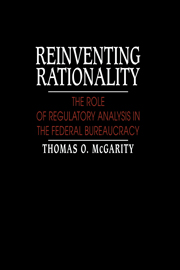Book contents
- Frontmatter
- Contents
- Acknowledgments
- Abbreviations
- Introduction
- Part I The clash of regulatory cultures
- Part II Regulatory analysis in theory and practice
- Part III Structuring regulatory analysis into the decisionmaking process
- Part IV Review of regulatory analysis
- Part V Conclusions
- 20 Analysis in the modern regulatory state
- Notes
- Bibliography
- Index
20 - Analysis in the modern regulatory state
Published online by Cambridge University Press: 16 October 2009
- Frontmatter
- Contents
- Acknowledgments
- Abbreviations
- Introduction
- Part I The clash of regulatory cultures
- Part II Regulatory analysis in theory and practice
- Part III Structuring regulatory analysis into the decisionmaking process
- Part IV Review of regulatory analysis
- Part V Conclusions
- 20 Analysis in the modern regulatory state
- Notes
- Bibliography
- Index
Summary
Regulatory analysis is currently in a state of awkward adolescence. It has emerged from its infancy, but it has not yet matured. It is often noisy and clumsy, and it generally commands little respect. Yet, despite its considerable shortcomings, it has important virtues. Every decisionmaker wants to make rational and informed decisions, and regulatory analysis can be very useful in sorting out the pros and cons of regulatory options. Perhaps more importantly, it can encourage the decisionmaker to articulate policy preferences and demonstrate to the public how those policy preferences were applied in important rulemaking initiatives. Like most adolescents, regulatory analysis also has great potential for the future. If the public, and particularly the beneficiaries of regulation, become convinced that it is not being used cynically to reach particular substantive results, regulatory analysis can become an effective tool for improving regulatory decisions and for enhancing the accountability of the bureaucracies to the public that they serve.
The conclusions of a high-level USDA employee who had an opportunity to observe the regulatory analysis process for many years at close range may provide an apt summary. This employee is enthusiastic about the theoretical value of regulatory analysis, but pessimistic about its current efficacy in the real world. Although some agencies have a strong analytical orientation, he believes that most bureaucrats, like most other other people, are not comfortable with thinking analytically. They bring their individual experience and intuition to bear on a problem, and when they are presented with a regulatory analyst's work product, they immediately search for the bottom line before agreeing with or critiquing that analysis.
- Type
- Chapter
- Information
- Reinventing RationalityThe Role of Regulatory Analysis in the Federal Bureaucracy, pp. 303 - 308Publisher: Cambridge University PressPrint publication year: 1991

